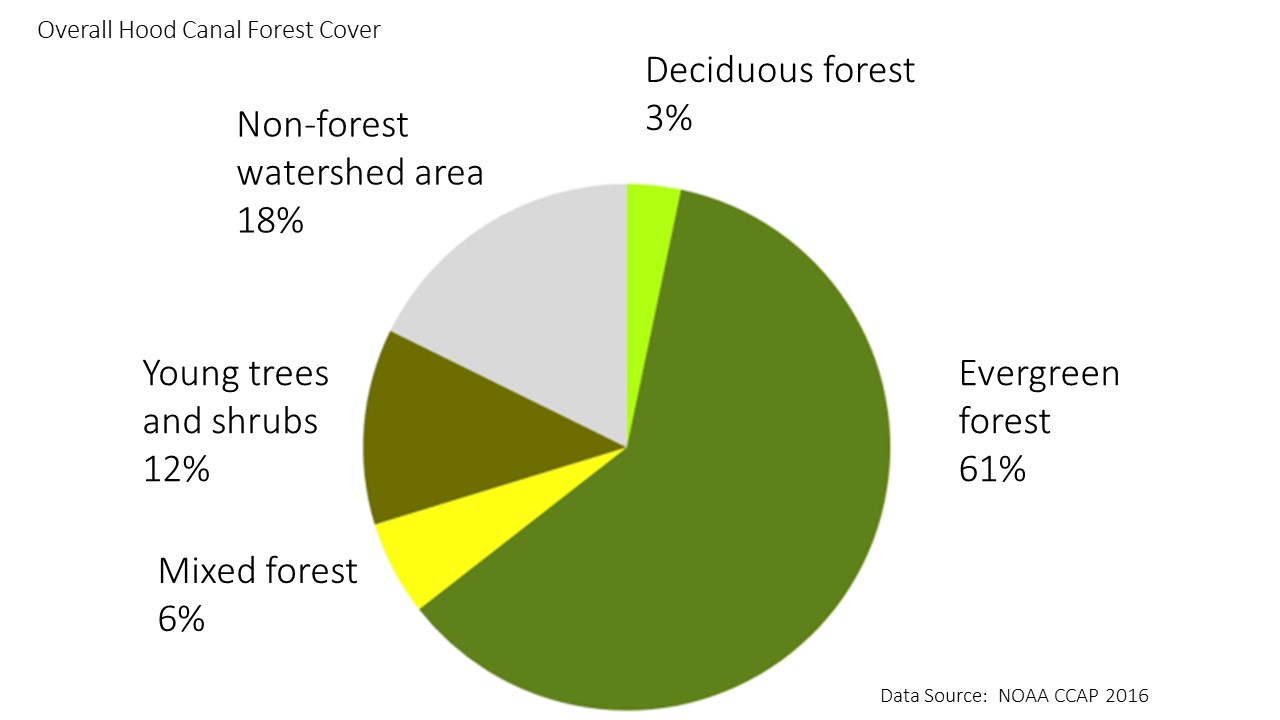
Hood Canal Forest Cover
Competing ecosystem and socio-economic interests present challenges to accomplishing Integrated Watershed Plan (IWP) goals for Hood Canal forests.
The Hood Canal Coordinating Council has drafted a list of pressures that impact Hood Canal forests, including primary challenges to:
- Balance forest harvest, conservation of wild forests, and residential development
- Maintain transportation infrastructure while minimizing forest fragmentation
Forest conversion has been concentrated in the coastal and lowland areas of Hood Canal. Between 1995 and 2006, approximately 24,500 acres were converted from forest to some other land use. The forest resources in different areas, and for varying uses, are subject to different pressures.
- Residential areas face pressures related to forest fragmentation and conversion
- Conservation and recreational lands are threatened by land use changes
- Timber lands are subject to rotational harvest and residential conversion
In addition, environmental conditions can impede efforts to restore and maintain forests requiring adaptive management actions that allow:
- Flexible response to climate change impacts such as severe weather events, altered temperature, and precipitation patterns
- Effective management of pests, fires, and other natural events
Forests are managed as protected public lands, working lands, and residential lands–forming a mosaic that supports our way of life.
A large portion of Hood Canal’s forests are managed as working lands, for timber production within national forest or on state or privately owned lands. The remaining forested areas are split between areas intended to accommodate residential development, and those that are managed primarily for conservation or recreational use.
Understanding how these different management regimes affect forest resources will help us in crafting the right strategies to meet Integrated Watershed Plan (IWP) goals.
Hood Canal Forest Management
Achieving healthy, properly functioning forests around Hood Canal means maintaining the amount of forest cover; improving the quality of our forests (more diversity in species and age class); and creating greater connectivity between forests and aquatic habitats. This will require implementing management strategies that:
- Increase wild and diverse forests (e.g., through reforestation)
- Maintain the area and productivity of managed, working timberlands in lieu of converting them to residential lands
- Maintain forest cover in residential lands (reducing fragmentation of existing stands)
There are a number of large-scale and community-based efforts designed to address the key challenges to achieve our Integrated Watershed Plan (IWP) Forest goals, including to:
- Review Habitat Conservation Plans that are used to manage and protect habitat, including marine waters, rivers, lakes, and associated forests, and the species that use them
- Review local land use ordinances and comprehensive plans
- Identify gaps in protection of forests and develop a plan to fill those gaps
- Align the aquatic protections identified within each Habitat Conservation Plan with local ordinances
- Obtain development rights in areas at threat of conversion
- Acquire lands that are better suited to conservation than timber or residential development
- Steward timber reproduction lands that are typically planted as monocultures to become more diverse with respect to species and age
- Support and encourage community forestry
Learn about what each of us can do to help Hood Canal forests.